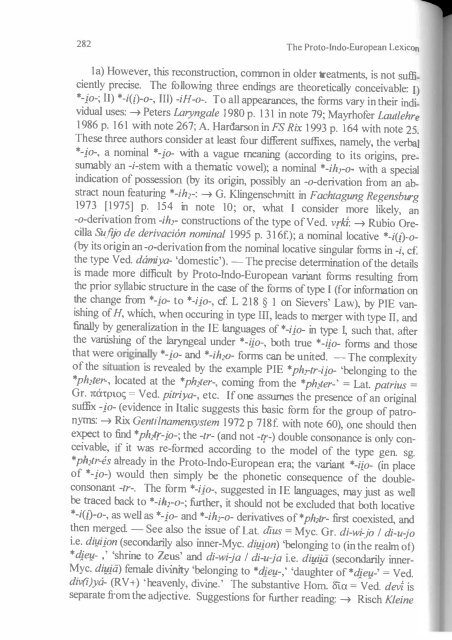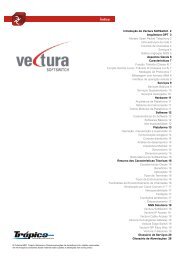Create successful ePaper yourself
Turn your PDF publications into a flip-book with our unique Google optimized e-Paper software.
282The Proto-Indo-European LexiCOnWord Formation283I a) However, this reconstruction, common in older treatments, is not sutlicientlyprecise. The fo llowing three endings are theoretically conceivable: I)*-jo-; IT) *-i(j)-o-, Ill) -iH-o-. To all appearances, the forms vary in their individualuses: Peters Laryngale 1980 p. 131 in note 79; Mayrh<strong>of</strong>er Laut/ehre1986 p. 161 with note 267; A. Hardarson in F.S'Rix 1993 p. 164 with note 25.These three authors consider at least fo ur different suffixes, namely, the verbal*-jo-, a nominal *-jo- with a vague meaning (according to its origins, presumablyan -i-stem with a thematic vowel); a nominal *-ih,-o- with a specialindication <strong>of</strong> possession (by its origin, possibly an -o-derivation from an abstractnoun featuring *-ih,-: G. Klingenschrnitt in Fachlagung Regensburg1973 [1975] p. 154 in note 10; or, what 1 consider more likely, an-o-derivation from -ih,- constructions <strong>of</strong> the type <strong>of</strong>Ved. vrkt: Rubio OrecillaSufljo de derivacion nominal 1995 p. 316f.); a nominal locative *-i(O-o(by its origin an -o-derivation from the nominal locative singular forms in -i, cf.the type Ved. damiya- 'domestic'). - The precise determination <strong>of</strong> the detailsis made more difficult by Proto-lndo-European variant fo rms resulting fromthe prior syllabic structure in the case <strong>of</strong> the fo rms <strong>of</strong> type 1 (for information onthe change from *-jo- to *-ijo-, cf. L 218 § I on Sievers' Law), by PIE vanishing<strong>of</strong> H, which, when occuring in type Ill, leads to merger with type IT, andfinally by generalization in the IE languages <strong>of</strong> *-ijo- in type I, such that, afterthe varushing <strong>of</strong> the laryngeal under *-ijo-, both true *-ijo- forms and thosethat were ori y *-jo- and *-ihzO- forms can he united. - The complexityf the sItuation IS revealed by the example PIE * ph,-Ir-ijo- 'helonging to theph2tr-, located at the *ph2Ier-, corning from the *ph2Ier-' = Lat. palrius =Gr. 1tmpto = Ved. pilriya-, etc. If one assumes the presence <strong>of</strong> an originalsuffix -jo- (evidence in Italic suggests this basic form for the group <strong>of</strong> patronyrns: Rix Genlilnamensyslem 1972 p 718f. with note 60), one should thenet to find *ph21{-jo-; the -Ir- (and not -tr-) double consonance is only conceIvable,if It was re-formed according to the model <strong>of</strong> the type gen. sg.*pIl2Ir-es already in the Proto-Indo-European era; the variant *-iio- (in place<strong>of</strong> *-jo-) would then simply he the phonetic consequence <strong>of</strong> -the doubleconsonant-Ir-. The form *-ijo-, suggested in IE 1anguages, may just as wellhe traced back to *-ill,-o-; further, it should not be excluded that both locative*-i(O-o-, as well as *-jo- and *-ih,-o- derivatives <strong>of</strong>*ph21r- first coexisted, andthen merged. - See also the issue <strong>of</strong> Lat. dius = Myc. Gr. di-wi·/o I di-u-joi.e. di!!ijon (secondarily also inner-Myc. di!!jon) 'belonging to (in the realm <strong>of</strong>)*djey- " 'shrine to Zeus' and di-wi-ja I di-u-ja i.e. di!!ijii (secondarily innerMyc. di!!jii) female divinity 'belonging to *djey-,' 'daughter <strong>of</strong> *djey-' = Ved.div(i)ya- (RV+) 'heavenly, divine.' The substantive Horn. &a = Ved. devI isseparate from the adjective. Suggestions for further reading: Risch Kleine1981 p. 580f.; Mayrhorer EWAia I p. 727 (which justly emphasSchriflen . sthat the Vedic form devi cannot share a heritage WIth Gr. &a); Hardarson IDFS J/jx 1993 p. 164-166. Particularly concerning Mycenaean: Aura JOTTODMic I 1985 p. 178fI; A. Leukart in Mykenaika 1992 p. 394 note 44. Forinformation on the special group <strong>of</strong>patronyrns, cf. W 302 § 3.Ib) l. Balles proposes a new view <strong>of</strong> the entire issue: Sprache 39 1997[2000] p. 141-167. The contribuion is based upon thesis paper fro Vienna.which the author submrtted ID 1996 under the directIon <strong>of</strong> J. Schindler.Following are the results in tabular form:A) -o-ab!. <strong>of</strong> AoOOCIOV < *16!!ki-o--i- stemwp6 (Myc. lu-rjo)< *tuHrj-6-III-io- -i(j) o-cf. Aves!. tuiri- n.'whey'B) -o-ab!. <strong>of</strong> a) relational * medhj-o- > IlEcr( cr) mediusloc. -i adjective *a/i-o- > iill.o aliusb) composl- E-aA.-tOstional suffixc) denomi- 9aA.6crcr-lnative ad- *sokWh,-jo- > *sokjo- > soc-iusectivelerl-iusd) verbal ii1tElPO < *1J-per-jo- iiy-tO, infer-ius,adjectiveexim-iusVed. ajur-ya- 12x (-ia- Ved. mGd-ia-Ix) 12xJ:!ta- 1&Commentary: - The author postulates (ibid., p.161f.) that the commonstarting point for the entire group are the -0- derivatives from -i locatives(B), which must he distinguished from the less numerous -0- derivatives<strong>of</strong> -i- stems (A), cf. AooocrOV (Theophrastus) 'white core <strong>of</strong> pine'





